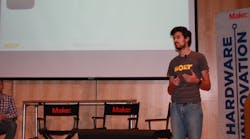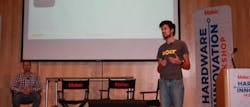The Maker Hardware Innovation Workshop held at the Maker Faire last week in the New York Hall of Science included a series of panels with speakers who discussed where the Maker Movement has been, where it’s going, and how makers can publicize their ideas. Here are their top five suggestions for becoming a successful and profitable businessperson.
1. Focus on a big problem, have a great vision, and create a great product.
Ben Einstein, co-founder of Bolt, a 6-month program designed to help hardware startups grow, outlined what new companies need to do to be successful: focus on a big problem people care about, have a great vision, and create a great product. By recognizing the problem before developing the product, you can gauge demand before you start drowning in your supply, says Emile Petrone of Tindie, an Etsy or online marketplace for hardware.
2. Build a community early.
Petrone also discussed the importance of building a community early by sharing your ideas with other makers early on. By using reddit, forums, or other open-source venues, you can get free feedback from people who could be future customers. Zach Kaplan, CEO of Inventables (an online hardware store for designers), gave examples of people creating products by building their own forums then using crowdsourcing sites such as Kickstarter to fund the manufacturing of their designs.
3. Have a plan for the worst case scenario, admit your mistakes, and move on.
Bunnie Huang, who was the hardware lead for Chumby, an embedded computer product, stressed the importance of being completely open during the entire process and planning for the worst-case scenario. Petrone echoed this idea, saying you must admit mistakes and move on or you’ll get stuck in endless battles.
4. Sometimes you just need a little help.
A common thread throughout the panels was to admit when you need help. Einstein, Kaplan, David Lang of OpenROV, and Dorian Ferlauto of ELIHUU, all discussed ways of reaching out while going from a maker to a manufacturer to a marketer. While ELIHUU is a sort of Match.com for designers and manufacturers, other services such as Dragon Innovation focus on crowd funding for larger-volume production. They claim that no matter what kind of help you need, there’s someone who has made it their mission to provide it.
5. Create a strong emotional bond with your customers.
Rob Coneybeer, managing director of Shasta Ventures, a venture firm for tech start-ups, discussed how to build strong emotional bonds with customers. By building a strong sense of brand, as well a great product, you create a full experience for people you are trying to reach. Coneybeer brought it back to what is arguably the simplest hardware: Lego, discussing how the company’s name is engraved six different times on their basic red black; providing a one-of-a-kind tactical experience. He went on to say that the “cheap, generic building blocks your Aunt would buy you” didn’t evoke the same feeling.

